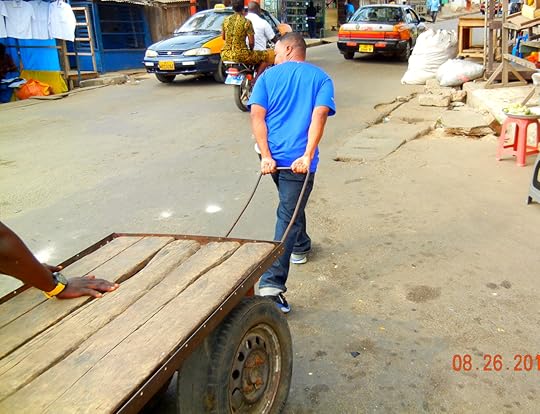Kwei Quartey's Blog, page 13
October 10, 2013
ALL THAT GLITTERS: ILLEGAL GOLD MINING IN GHANA–Chapter Three
1. Getting set
2. Expeditions to the hinterland ________________________________________________________________
1. Getting set
Kumasi was the base from which I launched all my expeditions to the gold mining areas. I had hired a driver, whom we’ll call Joe, for my entire trip. It’s customary for visitors to Ghana to rent a car along with a driver.
Kumasi is Ghana’s second largest city. We arrived around noon on a Saturday, and the first order of business was to settle into a marvelous hotel/B&B called Four Villages Inn, owned by Canadian-Ghanaian couple Chris and Charity Scott.
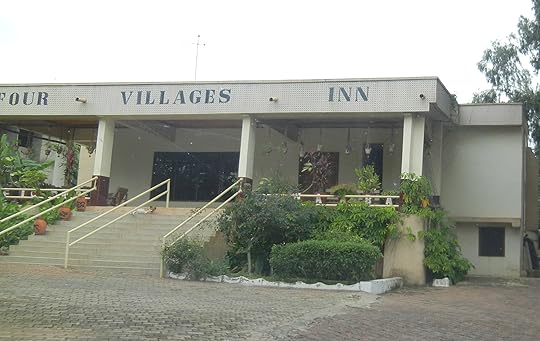
FOUR VILLAGES INN
(Photo Kwei Quartey)
Each of the four rooms has a theme. At FVI, you’re really staying in someone’s home, and not in a soulless hotel.
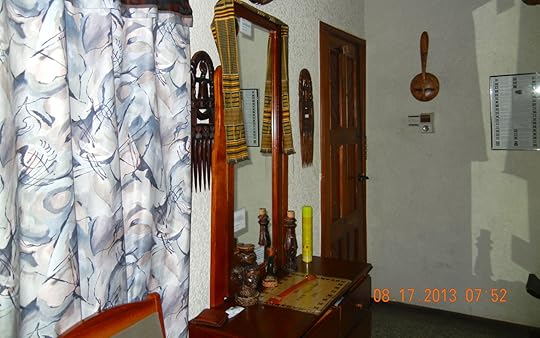
FVI “CARVER’S ROOM,” WHERE I STAYED
The day I arrived, I got in touch with a contact given to me while in Accra–a mechanic we’ll call Kojo, who works for the Obuasi Gold mine. We agreed we would meet the following day to discuss my needs in full. It’s about a 90 to 120-minute drive from Kumasi to Obuasi on a very good road. The state of the road to your destination is a primary factor in travel time management in Ghana.

KUMASI-OBUASI ROAD
(Photo Kwei Quartey)
Oh, one other thing–watch out for the checkpoint cops, who are very free with their radar guns and are happy to pull you over for speeding or anything else.
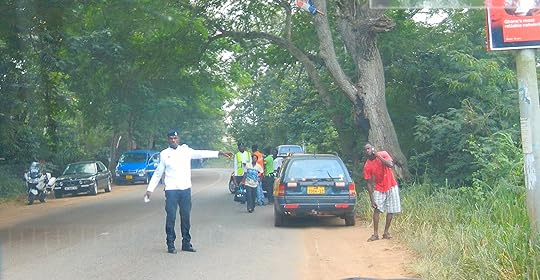
DRIVER’S LICENSE AND INSURANCE, PLEASE
(Photo Kwei Quartey)
The officer will aggressively tell you that he’s taking you to traffic court, you’ll beg, plead, argue, and ultimately offer him “a little something” to let you continue on your way.
Obuasi has a population of about 175,000. Its sister city in the US is Riverside, California. Like other towns of its size, Obuasi is rather quiet, although traffic can be surprisingly heavy at times.
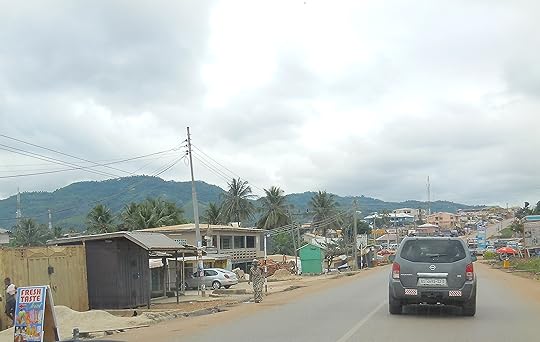
OBUASI HIGH STREET
(Photo Kwei Quartey)
Obuasi Mine, where Kojo works, is run by AngloGold Ashanti. It is one of the ten largest mines in the world, and is not to be confused with illegal gold mining in the area.

ANGLOGOLD ASHANTI–THIS IS LEGIT
(Photo Kwei Quartey)
I met Kojo Sunday around 11 a.m. at an outdoor restaurant , where we sat down for a drink and a chat. He was much younger than I had imagined from his voice on the phone, and very charismatic. I reiterated what I needed: to see everything possible related to illegal gold mining–safely. Not a problem. Kojo was happy to help. Born and bred in Obuasi, he knew where all the mines were. Even more importantly, he knew a lot of people particularly in the mining industry, in which he works himself. We settled on his per diem rate, and the next question was when to start. Kojo was willing to get going immediately, but after some discussion, he agreed with me that we ought to wait until I had talked to a senior officer at the Obuasi divisional headquarters of the Ghana Police Service. I wanted everything to be above board and find out if from a law enforcement perspective there was anything I needed to be aware of.
That meeting took place on Monday morning. The senior officer I spoke with was affable and knowledgeable. I had been referred to him by a detective friend of mine at CID Headquarters in Accra, and it helped that the senior officer knew my friend well. In Ghana, personal relationships and friendships are more important than formal policy and procedure. The meeting was successful and he shared some fascinating insights with me. The bottom line was, I was cleared for takeoff.
2. Expeditions into the hinterland
The following day, and over the next two weeks, Joe, Kojo and I set off to villages far off the beaten path. No more nice highways–this was brain-rattling, intestine-jiggling travel for which a 4×4 vehicle is essential. An ordinary sedan could be shaken to bits by some of these roads, and get stuck in deep mud during the rainy season.

A ROUGH ROAD DEEP INTO THE BUSH
(Photo Kwei Quartey)
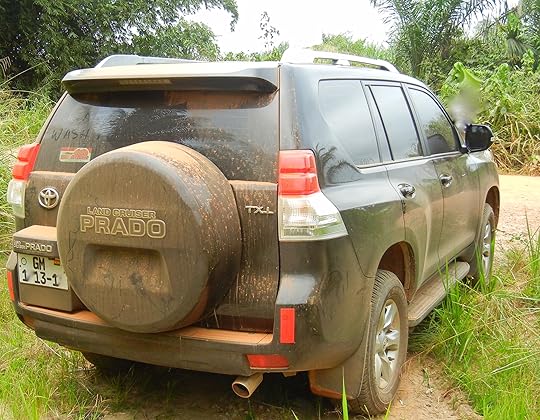
PUTTING THE LAND CRUISER PRADO THROUGH ITS PACES
(Photo Kwei Quartey)
Later on along the route, we came across a young man hanging off the back of a moving Land Rover being used as a commercial passenger vehicle–an example of one of the many things you see in Ghana that make you shake your head in disbelief. Check this out:
In the background you can someone on a religious radio station, which are legion in Ghana.
At a village called Amemriwa (“Ah-memry-wah”), we sat down with two men and a woman who lived there and whom Kojo knew from a prior visit.

WE SAT IN THE SHADE OF A TREE FOR OUR DISCUSSION
(Photo Kwei Quartey)
In more traditional societies in Ghana, there’s often an interval in which not much is said before the discussion gets underway. You will always be brought a seat, and there may be a ceremonial and unhurried shaking of hands. Just go with the flow. Your hosts will finally ask how they can help, or “what is your mission?”

A CURIOUS TEENAGER OBSERVES US
(Photo Kwei Quartey)
Kojo explained why we were there and what my particular interest was. He was very skillful at “adapting” the reason for my visit according to the audience. For some, he said I was writing a “storybook” about mining that would have illustrations, and therefore I needed to see the mining areas and take photos; with others he said that I was personally interested in starting up my own mining company.
But never would he say I was from the media–that would have set off alarm bells and make people clam up immediately and/or express hostility. What many Ghanaians, even in “remote” areas such as this, think of foreign media in particular is that they come, they see, they form their own ideas about what is going on, and then they return to their home countries to write slanderous untruths. So suspicion abounds, but Kojo is one of the most charming and reassuring speakers I know and the way he put everyone at ease was impressive. Very few of the excursions we made could have been done without his help.
The men from the village got in the Prado with us and we drove off toward the mines. We got to a spot that was impassable, so we parked and went the rest of the way on foot. Roads like this barreling through cleared forest were created almost invariably by the Chinese to provide access to mining areas.

KOJO (CENTER) WITH TWO MEN FROM THE VILLAGE
(Photo Kwei Quartey)
After about half a mile, we came across a Chinese man and three Ghanaians unloading some mining equipment from the back of a pickup. Definitely some activity going on here. 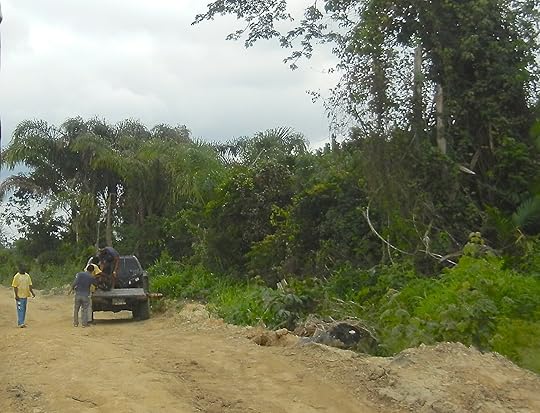 A few minutes later, we spotted the mining camp up ahead from which the men we had just seen must have been coming.
A few minutes later, we spotted the mining camp up ahead from which the men we had just seen must have been coming.

CORRUGATED METAL GATE TO THE CAMP
(Photo Kwei Quartey)
I was a little hesitant about approaching, but because our two guides from the village knew one or two of the Ghanaian workers in the camp, no issue arose. They chatted in Twi (the dominant indigenous language in Ghana), and I gather Kojo referred to my personal interest in mining as the rationale for my being there. There was one Chinese man there who was curious, and perhaps a little nervous, about our visit, but after figuring out that this was a non-threatening situation, he shook hands cordially with us. He said nothing and didn’t appear to speak any English. From the newness of the gate and the organized appearance of the compound, it was clear that this group was just getting started, and it turns out there was good reason for the Chinese man’s nervousness. Months before, there had been a violent conflict in this area between some Chinese miners and Ghanaians. Some time after that, the crackdown by the Ghana government had begun. It was impossible to tell if the Chinese men we were now encountering were ex-deportees or just among those who had hidden out or lain low during the purge. Obviously, I didn’t ask.
From the camp, we made our way to an illegal mine.

OVER THIS HILL IS AN ILLEGAL MINE
(Photo Kwei Quartey)
I was about to see an amazing sight.
Next chapter: Environmental destruction
September 27, 2013
ALL THAT GLITTERS: ILLEGAL GOLD MINING IN GHANA Chapter Two–Laying the groundwork
After South Africa, Ghana is the second largest gold producer in Africa, and over the last eight to nine years, thousands of people from China have streamed into Ghana, once famously known as the Gold Coast, in search of that yellow, glittery metal that human beings appear to go universally crazy over. Some estimate that Ghana has at least 1.75 billion ounces of gold in reserves. Many of the Chinese pouring into Ghana came from a particular area of their nation called Guangxi Province in Shanglin County, where an age-old tradition of gold mining exists and where local gold resources have dried up. Although Shanglin’s miners went looking for other gold-rich areas of China, e.g. Xinjiang and other provinces, the government came down hard on unscrupulous mining, and private operations were banned. Seeking other sources of gold outside China, the miners focused on Ghana’s rich resources, and behold, a mass exodus from China was born.
But Ghanaian law prohibits small-scale mining by non-citizens. For that reason alone, not to mention overstayed visas, the Chinese miners in Ghana have been engaged in illegal activity. The Guardian UK takes credit for bringing the story of massive illegal Chinese mining in Ghana to the forefront, revealing the appalling pits inflicted on the landscape in an accompanying video featuring Afua Hirsch. Other accounts emerged of Chinese miners being ambushed by Ghanaian armed robbers looking for cash and gold, Chinese miners using pump-action shotguns for protection, and at least two murders involving a Chinese man and a Ghanaian police officer.
Beginning May 2013, the Ghana government, via the military and special forces, launched a crackdown on the Chinese illegal immigrants and their operations. The picture was not pretty. Their cash and equipment were confiscated or looted, excavators and other machines were set alight, and the Chinese illegals were roughed up quite a bit and unceremoniously ejected from their mining camps and ultimately the country. In early June, 169 of them were arrested or detained. Ultimately the Chinese deportations from Ghana numbered in the thousands.
My Inspector Darko Dawson novels take social and/or economic issues in Ghana and make them the background for a murder or two (or three). This “gold-backed” turmoil in Ghana is tailor-made for Darko (and for me): conflict, social upheaval, greed, the search for riches in the midst of poverty, strong murder motives, and unlike the backdrop of prior novels Wife of the Gods and Children of the Street, real instances of distressing homicide. Having decided on that topic for the fourth Darko Dawson novel, Gold of the Fathers (tentative title), off I happily go to Ghana to research it, right? Well, not quite that simple. Before making a final determination about the trip, I had to research how I was going to do the research. It was important to make the right contacts–particularly with law enforcement, which was intimately involved with the Chinese debacle. Before I left for Ghana, I reached out to a good friend of mine at Accra’s Criminal Investigations Department (CID), a division of the Ghana Police Service (GPS).
He pointed me in the right direction: I needed to get in touch with the director of GPS Public Affairs. I arrived in Accra early September and wasted no time in seeking him out. He gave me permission to visit with and talk to the crime officer in Obuasi, the mining town referred to in my last post.
NEXT: The pockmarked landscape–seeing the mines for myself.
ALL THAT GLITTERS: LEGAL AND ILLEGAL GOLD MINING IN GHANA Chapter Two–Laying the groundwork
After South Africa, Ghana is the second largest gold producer in Africa, and over the last eight to nine years, thousands of people from China have streamed into Ghana, once famously known as the Gold Coast, in search of that yellow, glittery metal that human beings appear to go universally crazy over. Some estimate that Ghana has at least 1.75 billion ounces of gold in reserves. Many of the Chinese pouring into Ghana came from a particular area of their nation called Guangxi Province in Shanglin County, where an age-old tradition of gold mining exists and where local gold resources have dried up. Although Shanglin’s miners went looking for other gold-rich areas of China, e.g. Xinjiang and other provinces, the government came down hard on unscrupulous mining, and private operations were banned. Seeking other sources of gold outside China, the miners focused on Ghana’s rich resources, and behold, a mass exodus from China was born.
But Ghanaian law prohibits small-scale mining by non-citizens. For that reason alone, not to mention overstayed visas, the Chinese miners in Ghana have been engaged in illegal activity. The Guardian UK takes credit for bringing the story of massive illegal Chinese mining in Ghana to the forefront, revealing the appalling pits inflicted on the landscape in an accompanying video featuring Afua Hirsch. Other accounts emerged of Chinese miners being ambushed by Ghanaian armed robbers looking for cash and gold, Chinese miners using pump-action shotguns for protection, and at least two murders involving a Chinese man and a Ghanaian police officer.
Beginning May 2013, the Ghana government, via the military and special forces, launched a crackdown on the Chinese illegal immigrants and their operations. The picture was not pretty. Their cash and equipment were confiscated or looted, excavators and other machines were set alight, and the Chinese illegals were roughed up quite a bit and unceremoniously ejected from their mining camps and ultimately the country. In early June, 169 of them were arrested or detained. Ultimately the Chinese deportations from Ghana numbered in the thousands.
My Inspector Darko Dawson novels take social and/or economic issues in Ghana and make them the background for a murder or two (or three). This “gold-backed” turmoil in Ghana is tailor-made for Darko (and for me): conflict, social upheaval, greed, the search for riches in the midst of poverty, strong murder motives, and unlike the backdrop of prior novels Wife of the Gods and Children of the Street, real instances of distressing homicide. Having decided on that topic for the fourth Darko Dawson novel, Gold of the Fathers (tentative title), off I happily go to Ghana to research it, right? Well, not quite that simple. Before making a final determination about the trip, I had to research how I was going to do the research. It was important to make the right contacts–particularly with law enforcement, which was intimately involved with the Chinese debacle. Before I left for Ghana, I reached out to a good friend of mine, Frank, who is a detective at Accra’s Criminal Investigations Department (CID), a division of the Ghana Police Service (GPS), and has been of immeasurable assistance to me in the past.

THE CID BUILDING IN ACCRA
(Photo Kwei Quartey)
He pointed me in the right direction: First, I needed to get in touch with the director of GPS Public Affairs, Deputy Superintendent of Police (DSP) C. Arthur. I wrote the DSP a letter about six weeks before going to Ghana, along with a signed copy of Wife of the Gods, explaining my mission and my wish to speak to the crime officer at Obuasi, the mining town to which I referred in the previous post, about the present status of illegal mining in the Obuasi area and beyond. The GPS uses a “unitary” system of command. Whereas in the States one would go directly to, say, the commander or public relations officer of the police department of a particular town or jurisdiction, in Ghana all control is centralized in Accra. The district police can do nothing without permission from Headquarters. (I have learned this the hard way in previous visits to Ghana.)
I arrived in Accra early September and wasted no time in seeking out DSP Arthur, whose office is in the Ghana Police Service Headquarters next door to the CID building. For reasons I’ve never figured out, security at CID is relaxed, while at the GPS building it is tight in comparison. For example, you must check in your mobile phone at the security post before entering the GPS building, or you will be in big trouble.
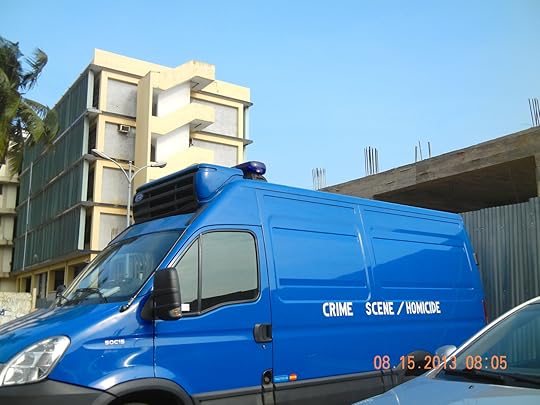
NEW CRIME SCENE VEHICLE WITH GHANA POLICE HQ IN THE BACKGROUND
(Photo Kwei Quartey)
Any anxieties I might have entertained about my reception by DSP Arthur were immediately allayed when I met him, as he was very affable and easygoing. He had received my letter and the novel and was very appreciative. An English major, Arthur confessed to me that he had begun writing a novel years ago but hadn’t completed it. I encouraged him not to give up! Regarding my research and the purpose of my visit, he gave me unqualified permission to visit with and talk to the crime officer in Obuasi. The crime officer, who was a good friend of Arthur’s, also used to share an office with Frank’s immediate superior, DSP Gove, with whom I’d established cordial relations on previous trips. These kinds of connections work especially well in Ghana, where personal relationships are often of greater value than formal policy and procedure.
I made another fortunate link before I left Accra to head north to the Ashanti Region. An author and professor at the University of Ghana Laura J. McGough, who did a review of Wife of the Gods in 2009 and is writing her own murder mystery (and also happens to be an awesome kick-boxer), put me in touch with acclaimed photographer Nii Obodai, who is collaborating with journalist Yiting Sun to tell the story of Chinese illegal mining in Ghana. Yiting has already written articles on the subject for the New York Times. I called up Nii Obodai and he said he and Yiting would be happy to talk to me. We met first thing in the morning at DeliFrance, a lovely cafe (in front of Esther’s Hotel), where you are as likely to hear Lebanese, German and French being spoken as you are to hear English and the Ghanaian languages, reflecting Accra’s cosmopolitan character.

DELIFRANCE CAFE
(Photo Samuel Mensah)
Nii and Yiting were very helpful in setting the scene for me, describing what they had seen over their travels in the mine-ravaged Ashanti Region. “Is it dangerous to visit these mining sites?” I asked, a trifle anxiously. “No,” Yiting told me, matter-of-factly. As I was about to discover, the image I had conjured up as a result of media reports of pitched gun battles between warring Chinese and Ghanaian people was wildly off the mark.
But it was the contact that Nii Obodai and Yiting in turn provided me that was to prove to be a godsend: Kwame, a taxi owner and machine operator who lives in the Obuasi area and works for AngloGold Ashanti, had been their guide to multiple mining sites, both deserted (by the Chinese) and operational. With Kwame’s savvy and extensive knowledge of the area, I was about to be treated to quite a bit of adventure.
NEXT: The pockmarked landscape–seeing the mines for myself.
September 12, 2013
ALL THAT GLITTERS: LEGAL AND ILLEGAL GOLD MINING IN GHANA Chapter One–Going back in time
During August-September 2013, I was in Ghana researching illegal gold mining in that country as I prepare to write the fourth Inspector Darko Dawson novel, Gold of Our Fathers (title only tentative). The current fever over gold in Ghana has been heightened and complicated by the influx of Chinese gold-seekers with no legal standing to conduct mining in Ghana. To put the chaos in context, a brief historical look is in order. It’s not an exhaustive review by any means.
History of gold in Ghana*
Ghana was called the Gold Coast until it became independent in 1957 and assumed its modern name. In the fifteenth century, Europeans knew the West African coastal area as the source of the gold that reached North Africa via the trans-Saharan trade roots. Gold had been traded to Europe at least as early as the tenth century. When the Portuguese arrived at the Gold Coast in 1471, they called their landing area La Mina, or The Mine, a pointed reference to the gold they discovered. That name became corrupted to Elmina.
For centuries, gold was panned and mined from the quartz reefs of Ashanti by local gold seekers called galamsey. In the 1870s, a Frenchman Marie Joseph Bonnat exploited gold concessions on the Ankobra River, but he died in 1882, and it was only toward the end of the 19th century that the idea of organized, large-scale mining began to gain strength. By 1890, three Ghanaian entrepreneurs with the same first name of Joseph–Biney, Ellis, and Brown–had founded the Ashanti Goldfields Corporation (AGC). In November of 1897, about 44 tons of heavy mining machinery arrived at Cape Coast Castle. Using laborers to carry backbreaking machine parts through forbidding forests and across powerful rivers, the company transported all the equipment from the coast some 120 miles north to begin work in the Obuasi district. Biney, Ellis and Brown thus opened the modern era of Ashanti gold.
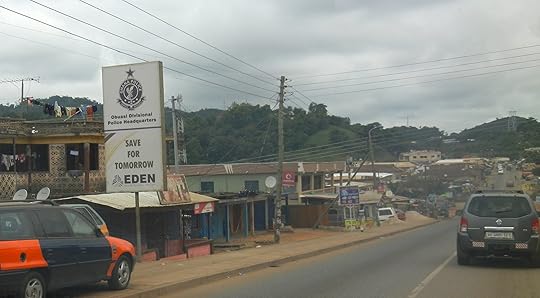
PRESENT-DAY OBUASI; MAIN STREET, 2013
(Photo Kwei Quartey)
Obviously the British, who made the Gold Coast a crown colony in 1874, coveted all that gold. With the overthrow of the Ashanti king in 1896, the Ashanti protectorate was brought directly under British control, and the London-based firm Smith & Cade was given approval to mine the region for gold. From March 1898 to June 1899, 3,426 tons of ore yielded 2,544 ounces of gold, and the yield was even greater the following year.
Initially, gold futures appeared very bright, but the War of the Golden Stool, the 1900 uprising led by the Ashanti Queen Mother against the British, drove operations to a crashing halt. By 1904-5, there was much disappointment over the diminishing reserves of gold, and a leading chemist and mining engineer commissioned to independently assess the mines condemned the then method of mining shallow, easily accessible ore.
Post-war and modern developments
After the two world wars, many Ashanti gold mines had closed down and the industry was in a state of stagnation. By then, the AGC was headed by an autocratic Sir Edward Spears, who lived abroad and rarely visited the company’s operations, treating it as “a personal fiefdom,” according to AGC company history.
During the tumultuous years from the 1966 military toppling of Dr. Kwame Nkrumah to the 1982 military regime of Flight Lieutenant Jerry Rawlings, Spears was deposed from his position by the London and Rhodesia Mining and Land Company (Lonrho.) During Rawlings’s rule, the AGC began to do better, and Sam Jonah, the new managing director and first Ghanaian chief executive, oversaw a radical improvement starting in 1986. AGC’s most productive mine is Obuasi, which, despite over 100 years of continuous operation, is still one of the top-producing mines in the world and the largest mine in Africa outside South Africa.

PREVIOUSLY MINED MOUNTAINTOP AREA NEAR OBUASI
(Photo Kwei Quartey)
Over a century after its incorporation, AGC, Ltd of Accra remains one of the largest producers of gold in the world, achieving an annual gold production of 1.74 million ounces in 2000. It is also one of Ghana’s largest earners of foreign funds and the only mining operation on the New York and London stock exchanges run by black Africans. AngloGold Ashanti Limited is a global gold-mining company formed in 2004 by the merger of Anglo Gold and the Ashanti Goldfields Corporation.

(Photo Kwei Quartey)
The starkest observation about gold in Ghana and anywhere else for that matter is that man’s and woman’s appetite and desire for the yellow, glittery metal remains as powerful and compelling now as in any other past era. There appears to be an innate and irresistible human attraction to gold, and it is this insatiable lust that is driving the present mining upheaval in Ghana, the country once called the Gold Coast.
NEXT: Gold fever in modern Ghana and the Chinese invasion.
*Much of this information taken from History of the Ashanti Goldfields Company
ALL THAT GLITTERS: LEGAL AND ILLEGAL GOLD MINING IN GHANA Chapter One
During August-September 2013, I was in Ghana researching illegal gold mining in that country as I prepare to write the fourth Inspector Darko Dawson novel, Gold of Our Fathers (title only tentative). The current fever over gold in Ghana has been heightened and complicated by the influx of Chinese gold-seekers with no legal standing to conduct mining in Ghana. To put the chaos in context, a brief historical look is in order. It’s not an exhaustive review by any means.
History of gold in Ghana*
Ghana was called the Gold Coast until it became independent in 1957 and assumed its modern name. In the fifteenth century, Europeans knew the West African coastal area as the source of the gold that reached North Africa via the trans-Saharan trade roots. Gold had been traded to Europe at least as early as the tenth century. When the Portuguese arrived at the Gold Coast in 1471, they called their landing area La Mina, or The Mine, a pointed reference to the gold they discovered. That name became corrupted to Elmina.
For centuries, gold was panned and mined from the quartz reefs of Ashanti by local gold seekers called galamsey. In the 1870s, a Frenchman Marie Joseph Bonnat exploited gold concessions on the Ankobra River, but he died in 1882, and it was only toward the end of the 19th century that the idea of organized, large-scale mining began to gain strength. By 1890, three Ghanaian entrepreneurs with the same first name of Joseph–Biney, Ellis, and Brown–had founded the Ashanti Goldfields Corporation (AGC). In November of 1897, about 44 tons of heavy mining machinery arrived at Cape Coast Castle. Using laborers to carry backbreaking machine parts through forbidding forests and across powerful rivers, the company transported all the equipment from the coast some 120 miles north to begin work in the Obuasi district. Biney, Ellis and Brown thus opened the modern era of Ashanti gold.

PRESENT-DAY OBUASI; MAIN STREET, 2013
(Photo Kwei Quartey)
Obviously the British, who made the Gold Coast a crown colony in 1874, coveted all that gold. With the overthrow of the Ashanti king in 1896, the Ashanti protectorate was brought directly under British control, and the London-based firm Smith & Cade was given approval to mine the region for gold. From March 1898 to June 1899, 3,426 tons of ore yielded 2,544 ounces of gold, and the yield was even greater the following year.
Initially, gold futures appeared very bright, but the War of the Golden Stool, the 1900 uprising led by the Ashanti Queen Mother against the British, drove operations to a crashing halt. By 1904-5, there was much disappointment over the diminishing reserves of gold, and a leading chemist and mining engineer commissioned to independently assess the mines condemned the then method of mining shallow, easily accessible ore.
Post-war and modern developments
After the two world wars, many Ashanti gold mines had closed down and the industry was in a state of stagnation. By then, the AGC was headed by an autocratic Sir Edward Spears, who lived abroad and rarely visited the company’s operations, treating it as “a personal fiefdom,” according to AGC company history.
During the tumultuous years from the 1966 military toppling of Dr. Kwame Nkrumah to the 1982 military regime of Flight Lieutenant Jerry Rawlings, Spears was deposed from his position by the London and Rhodesia Mining and Land Company (Lonrho.) During Rawlings’s rule, the AGC began to do better, and Sam Jonah, the new managing director and first Ghanaian chief executive, oversaw a radical improvement starting in 1986. AGC’s most productive mine is Obuasi, which, despite over 100 years of continuous operation, is still one of the top-producing mines in the world and the largest mine in Africa outside South Africa.

PREVIOUSLY MINED MOUNTAINTOP AREA NEAR OBUASI
(Photo Kwei Quartey)
Over a century after its incorporation, AGC, Ltd of Accra remains one of the largest producers of gold in the world, achieving an annual gold production of 1.74 million ounces in 2000. It is also one of Ghana’s largest earners of foreign funds and the only mining operation on the New York and London stock exchanges run by black Africans. AngloGold Ashanti Limited is a global gold-mining company formed in 2004 by the merger of Anglo Gold and the Ashanti Goldfields Corporation.

(Photo Kwei Quartey)
The starkest observation about gold in Ghana and anywhere else for that matter is that man’s and woman’s appetite and desire for the yellow, glittery metal remains as powerful and compelling now as in any other past era. There appears to be an innate and irresistible human attraction to gold, and it is this insatiable lust that is driving the present mining upheaval in Ghana, the country once called the Gold Coast.
NEXT: Gold fever in modern Ghana and the Chinese invasion.
*Much of this information taken from History of the Ashanti Goldfields Company
ALL THAT GLITTERS: LEGAL AND ILLEGAL GOLD MINING IN GHANA Part One
During August-September 2013, I was in Ghana researching illegal gold mining in that country as I prepare to write the fourth Inspector Darko Dawson novel, Gold of Our Fathers (title only tentative). The current fever over gold in Ghana has been heightened and complicated by the influx of Chinese gold-seekers with no legal standing to conduct mining in Ghana. To put the chaos in context, a brief historical look is in order. It’s not an exhaustive review by any means.
History of gold in Ghana*
Ghana was called the Gold Coast until it became independent in 1957 and assumed its modern name. In the fifteenth century, Europeans knew the West African coastal area as the source of the gold that reached North Africa via the trans-Saharan trade roots. Gold had been traded to Europe at least as early as the tenth century. When the Portuguese arrived at the Gold Coast in 1471, they called their landing area La Mina, or The Mine, a pointed reference to the gold they discovered. That name became corrupted to Elmina.
For centuries, gold was panned and mined from the quartz reefs of Ashanti by local gold seekers called galamsey. In the 1870s, a Frenchman Marie Joseph Bonnat exploited gold concessions on the Ankobra River, but he died in 1882, and it was only toward the end of the 19th century that the idea of organized, large-scale mining began to gain strength. By 1890, three Ghanaian entrepreneurs with the same first name of Joseph–Biney, Ellis, and Brown–had founded the Ashanti Goldfields Corporation (AGC). In November of 1897, about 44 tons of heavy mining machinery arrived at Cape Coast Castle. Using laborers to carry backbreaking machine parts through forbidding forests and across powerful rivers, the company transported all the equipment from the coast some 120 miles north to begin work in the Obuasi district. Biney, Ellis and Brown thus opened the modern era of Ashanti gold.

PRESENT-DAY OBUASI; MAIN STREET, 2013
(Photo Kwei Quartey)
Obviously the British, who made the Gold Coast a crown colony in 1874, coveted all that gold. With the overthrow of the Ashanti king in 1896, the Ashanti protectorate was brought directly under British control, and the London-based firm Smith & Cade was given approval to mine the region for gold. From March 1898 to June 1899, 3,426 tons of ore yielded 2,544 ounces of gold, and the yield was even greater the following year.
Initially, gold futures appeared very bright, but the War of the Golden Stool, the 1900 uprising led by the Ashanti Queen Mother against the British, drove operations to a crashing halt. By 1904-5, there was much disappointment over the diminishing reserves of gold, and a leading chemist and mining engineer commissioned to independently assess the mines condemned the then method of mining shallow, easily accessible ore.
Post-war and modern developments
After the two world wars, many Ashanti gold mines had closed down and the industry was in a state of stagnation. By then, the AGC was headed by an autocratic Sir Edward Spears, who lived abroad and rarely visited the company’s operations, treating it as “a personal fiefdom,” according to AGC company history.
During the tumultuous years from the 1966 military toppling of Dr. Kwame Nkrumah to the 1982 military regime of Flight Lieutenant Jerry Rawlings, Spears was deposed from his position by the London and Rhodesia Mining and Land Company (Lonrho.) During Rawlings’s rule, the AGC began to do better, and Sam Jonah, the new managing director and first Ghanaian chief executive, oversaw a radical improvement starting in 1986. AGC’s most productive mine is Obuasi, which, despite over 100 years of continuous operation, is still one of the top-producing mines in the world and the largest mine in Africa outside South Africa.

PREVIOUSLY MINED MOUNTAINTOP AREA NEAR OBUASI
(Photo Kwei Quartey)
Over a century after its incorporation, AGC, Ltd of Accra remains one of the largest producers of gold in the world, achieving an annual gold production of 1.74 million ounces in 2000. It is also one of Ghana’s largest earners of foreign funds and the only mining operation on the New York and London stock exchanges run by black Africans. AngloGold Ashanti Limited is a global gold-mining company formed in 2004 by the merger of Anglo Gold and the Ashanti Goldfields Corporation.

(Photo Kwei Quartey)
The starkest observation about gold in Ghana and anywhere else for that matter is that man’s and woman’s appetite and desire for the yellow, glittery metal remains as powerful and compelling now as in any other past era. There appears to be an innate and irresistible human attraction to gold, and it is this insatiable lust that is driving the present mining upheaval in Ghana, the country once called the Gold Coast.
NEXT: Gold fever in modern Ghana and the Chinese invasion.
*Much of this information taken from History of the Ashanti Goldfields Company
August 31, 2013
UPDATING MY CV
An MD normally follows my name, but I will now add CCW, CCT, CTW, and CTP, which stand for Certified Canopy Walker, Certified Crocodile Tamer, Certified Toad Whisperer, and Certified Truck-Pusher.
Certified Canopy Walker (CCW)
For years, I have been promising myself that I would visit Kakum National Park, so on this trip I snatched a bit of time between trips to and from Takoradi and Kumasi (more on Kumasi later).
Kakum is famous (infamous?) for footbridges 130 feet (twelve stories) high suspended from one giant tree to another above a rich forest canopy. It is notorious for making people sweat at the thought of plunging into the depths, and for causing acrophobic subjects to stop dead in their tracks, gripped by paralyzing panic.
Twelve stories may not seem a big deal when you’re in a building, but when you’re on this bouncy contraption, it can be another matter altogether:

THE WALK IS DESIGNED TO GIVE BENEATH YOUR FEET, WHICH IS PART OF WHAT BOTHERS SOME WOULD-BE CROSSERS
In fact the walk was not as scary for me as I had imagined, partly because I had imagined that the bridge swings wildly from side to side. In fact the movement is primarily up and down and it really isn’t that bad. Apart from that, I love forests and find them soothing and awe-inspiring. Those of you who have read Wife of the Gods know that a rather unusual forest scene forms the prologue.

BREATHTAKING VIEWS OF THE FOREST FROM THE WALKWAY
At the end of each of the three bridge sections, there is a safe-station secured to a tree, from which you move on to the next segment. The height is most dizzying at the third bridge, which reaches the highest point. Nevertheless, as you can see on this vid of me making the crossing, there’s nothing to be afraid of . . .or is there? A little less mischievous than the preceding video is this clip of an experienced Kakum walker.
Once you’re down from the bridges, you’ll realize how much fun it was, and then you can take a rest and gulp down a bottle of water as your reward for surviving the walkway.
Certified Crocodile Tamer (CCT)–sort of
Not far from Kakum is a frequent stopover for walkway survivors, Hans Cottage Botel, a hotel and guest house lodging notable for its proximity to a lake teeming with wildlife. Many herons and other birds populate the area.
[image error]
AN EGRET RESTING AMONG THE “UPSIDE-DOWN” NESTS CONSTRUCTED BY MASTER-BUILDER WEAVER BIRDS
But the most prominent animals are undoubtedly the crocodiles, which I personally could stare at all day long in fascination.

THE CROCS THERMOREGULATE BY SUNBATHING AND KEEPING THEIR MOUTHS OPEN FOR HEAT EXCHANGE
For five cedis, about $2.30, you can “pet” a crocodile, and another five will buy morsels of raw chicken, which one of the caretakers will feed a crocodile for your viewing pleasure.

SAY HI TO MY NEW REPTILIAN FRIEND
Of course, crocodiles have a reputation of being vicious, aggressive and lethal. Footage shown ad nauseam of the crocodilian massacre of wildebeest during the great Serengeti crossing of the Mara River probably doesn’t help to establish them as cuddly pets safe around the kids. However docile crocodiles are documented in quite spectacular fashion in the far northern Ghanaian town of Paga, where fascinated tourists marvel at crocodiles who have no objection to being touched, stroked, or even sat on. I would postulate that a creature who has stuck around for a couple hundred of millions of years is smart enough not to bite the hand that feeds it, and the crocs both here at Hans and in Paga are a well-fed bunch. Watch this clip of a Hans attendant trying to feed a reluctant crocodile that simply wanted to take a nap and be left alone. It had earlier had a full breakfast of raw chicken and that was quite enough.
Obviously my qualification as a crocodile tamer is very dubious, since I arrived to find them in an already docile and domesticated state, but let’s just pretend.
Certified Toad Whisperer (CTW)
 Walking through a cool cocoa grove, I spotted a little toad hopping across the pathway. It was fawn with a hint of pink, and so close to the color of the ground I would have missed it if it had stayed still.
Walking through a cool cocoa grove, I spotted a little toad hopping across the pathway. It was fawn with a hint of pink, and so close to the color of the ground I would have missed it if it had stayed still.
To my surprise, it didn’t move when I came closer, and of even greater surprise to me, it didn’t appear to mind stopping for a few moments to be gently “petted.” Since my interaction with toads has been mostly dissecting them in biology class in secondary school, I was happy to exchange this friendly moment with the little fellow. After a few moments, the toad hopped happily away to continue its journey.

IT APPEARED CONTENT TO BE GENTLY STROKED
Certified Truck-Pusher (CTP)
All across Ghana’s cities, teenaged boys and young men push four-wheeled carts from place to place, transporting scrap metal, car parts, electronic supplies and other sundries.
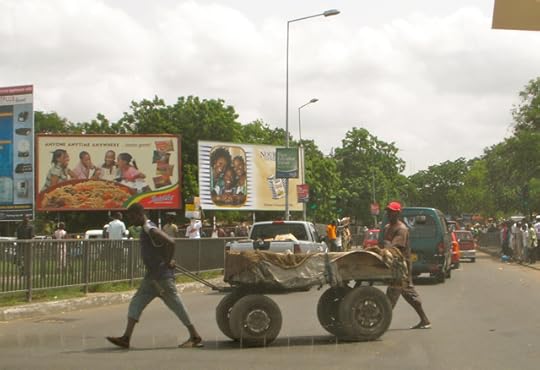
A PAIR OF TRUCK-PUSHERS CROSS THE SOUTHERN END OF BARNES ROAD IN ACCRA
At the very lowest rung of the socioeconomic ladder, these tireless youngsters are nevertheless an essential part of the informal recycling sector. Not that electronics recycling in particular is safe, but it could be argued that truck-pushers have a narrowly-defined role of picking up scrap in one place and delivering it to another, and therefore they can’t exactly be “held responsible” for the dangers of taking electronic components apart.
For some reason, I have been long fascinated by the work truck-pushers do (they feature heavily in my second novel, Children of the Street) and I’ve always wanted to find out what pulling or pushing one of these carts is like. While briefly in Cape Coast, I had my chance. A friendly truck-pusher obligingly allowed me to get the feel of it.

HIS LUCKY DAY: I GAVE HIM A PHAT TIP
The cart was very heavy, and I didn’t even have a load on it! Remember that these workers have ten to sixteen hours of toil, most of it under the merciless equatorial sun. I doubt I’ll be doing that anytime soon, but still, I’ve finally fulfilled my wish to pull a truck-pusher’s cart. The kids below apparently approved (they weren’t really there–I’m just looking for an excuse to show off one of my prized photos.)
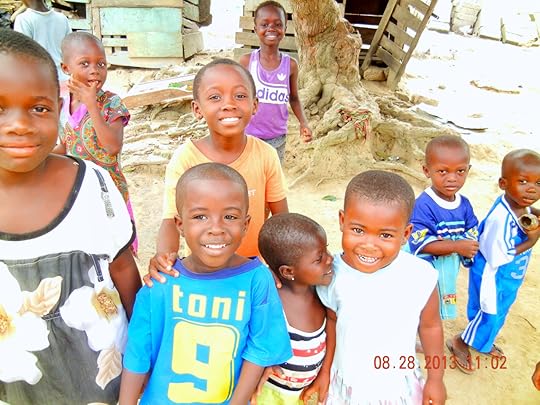
DELIGHTFUL KIDS IN THE HINTERLAND
August 27, 2013
NORTH BY NORTHWEST
Kumasi is the second largest city in Ghana. I used Kumasi as a base from which to launch my excursions to areas where illegal alluvial gold mining is practiced. More on this in upcoming blogs, but it will form the backdrop of my fifth Darko Dawson novel, Gold of My Fathers.
Kumasi in the Ashanti Region is about 124 miles northwest of Accra. The present road between the two cities was constructed over several years with interest-free funding from China in 2003. It has made a tremendous difference to the once nightmarish journey plagued by appalling road conditions.
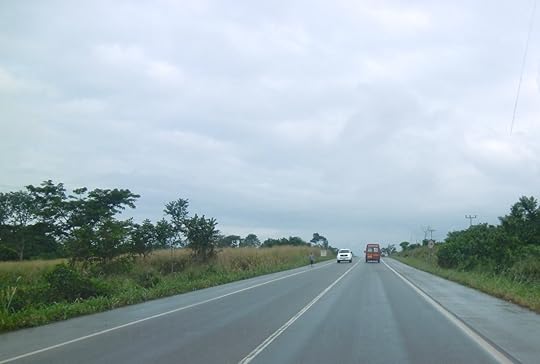
SMOOTH ALL THE WAY EXCEPT FOR ONE INCOMPLETE SECTION
The Ashanti Region is heavily forested with banana, coconut, oil palm and cocoa trees, as well as the giants such as the onyina.

ROAD CUTS THROUGH THICK FOREST
However, a dismayingly large proportion of Ghana’s forests has been destroyed through land development, over- cutting, and burning. Firewood remains an important fuel source for many villages.
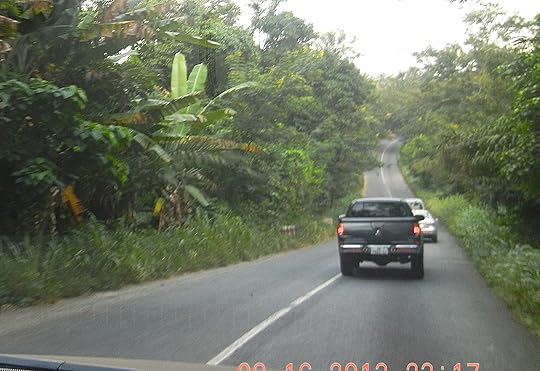
AS THICK AS THE FOREST MAY SEEM, IT HAS BEEN DEPLETED OVER WIDE AREAS OF GHANA

MIGHTY ONYINA TREE TOWERS OVER OTHER VEGETATION
Arboreta, national parks, and botanical gardens are one way that Ghana attempts to preserve and recover lost forest, but in many cases it’s too late.
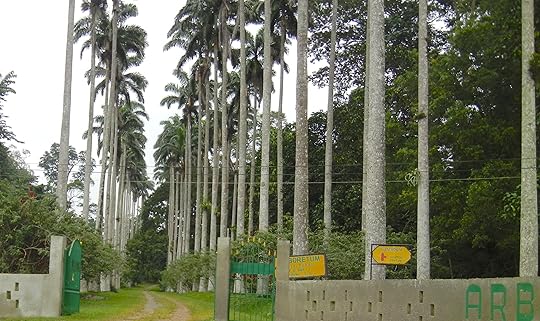
BUNSO ARBORETUM ON THE ACCRA-KUMASI ROUTE
It’s commonplace in the Ashanti Region to encounter cocoa trees at the roadside. Cocoa is what produces the chocolate that is so beloved throughout the world. Ghana is the second largest producer of cocoa after neighboring Cote d’Ivoire. The two countries produce most of the world’s cocoa. In fact, if either or both should experience a catastrophic loss of production in any one year, the price of chocolate would almost certainly rise as world cocoa commodity prices shoot up.
The cocoa fruit all begins with a small flower, which is pollinated by a tiny fly called Forcipomyia, but sometimes artificial techniques are used to increase the yield.

THE TINY COCOA FLOWER NEEDS A TINY FLY TO POLLINATE IT
Cocoa is unusual in many ways, among them that it bears fruit both on its branches and the stem, and since it flowers all year long, fruit at all different stages coexist with flowers at any one time.

COCOA TREE BEARING RIPENING PODS
There is little resemblance between chocolate, the end product, and its source, the cocoa pod, in which thirty to forty seeds are found. The ripe pod is a beautiful golden-yellow color. Young pods may be green or reddish, which is a normal variant.

RIPE COCOA POD
The seeds are coated with a white mucilage–almost like a soft packing material–which is tangy to the taste and quite delicious to many people, including me. Later, after processing, the seeds will lose the white stuff and become golden brown beans.

COCOA SEEDS PACKED IN A POD

YUM–I LOVES ME SOME COCOA SEEDS
By the way, after sucking on the seeds, you don’t swallow them! But no harm done if you do. The worst thing that could result is a miniature cocoa tree in your GI tract, and then you can have chocolate whenever you like. I jest, of course.
Next blog: canopy-walking, crocodile-wrestling (well, not quite), palm wine-making, truck-pushing and . . . toad-whispering.
August 20, 2013
SIGHTS OF ACCRA 2013
Accra is the capital of Ghana, and the largest city in the country with an estimated urban population of around 4 million. It has the kind of personality and character that sometimes makes one think, “Only in Accra,” in the same way one might say “Only in LA,” or “Only in New York.”
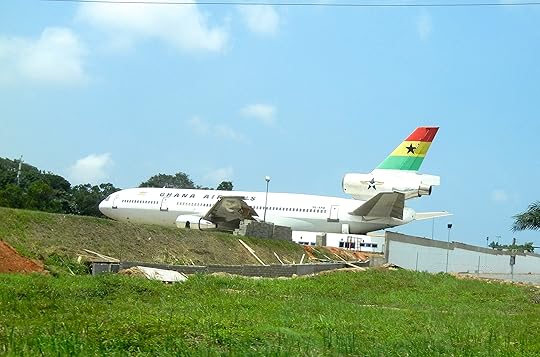
GHANA’S OLD DC-10
This is not the aircraft on which I flew into Ghana. It’s the country’s old DC-10 skeleton being refurbished in a field close to the airport–not to be flown again, but to my understanding, for use in emergency training. In 2004, Ghana Airways was disallowed entry to the US because of alleged safety violations, and due to intractable debt, the airline was liquidated in 2005.
Meanwhile, the building boom in Accra continues–both homes and businesses, and of the latter, new hotels appear to form a good proportion. Because loans are extremely difficult to obtain from Ghanaian banks and have a prohibitive APR of 25% or more, most build homes or businesses on a cash-only basis. Unless lending in Ghana becomes similar to that in the US, a housing crash of the American 2008 variety is unlikely.
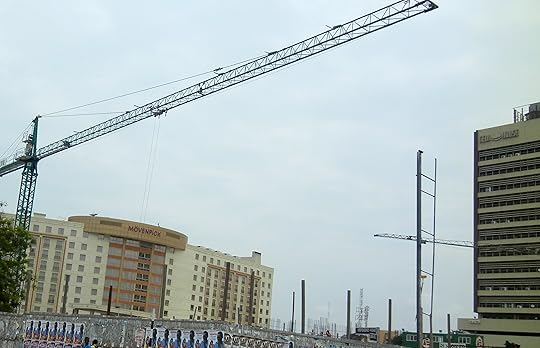
MORE CONSTRUCTION NEAR THE 5-STAR MOVENPICK HOTEL, AN INTERNATIONAL CHAIN BASED IN SWITZERLAND.
The Movenpick is one such very large hotel project completed in the last couple of years. Its interior (below) is soulless, a bit on the ostentatious side, as many large hotels are, and not particularly appealing to me (compared to say something small and personal like Esther’s Hotel)–although I concede Movenpick does put on a good Sunday brunch.
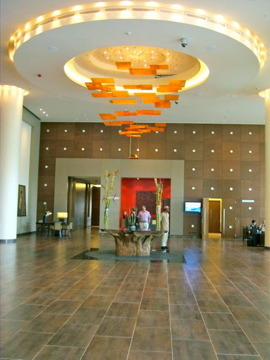
MOVENPICK LOBBY
But only tens of meters away are reminders that flashy hotels are only an illusion of true wealth, and what wealth there is is severely maldistributed. On the street, begging from the likes of the disabled woman shown below (pushed in a wheelchair in traffic by her caretaker) is quite relentless, and although visitors may find it distressing, locals are long desensitized.

DISABLED AND WHEELCHAIR-BOUND WOMAN. OTHERS COMMONLY SEEN ARE BLIND BEGGARS LED AROUND ALL DAY LONG BY A SCHOOL-AGED CHILD
Life does go on, however, and commercial enterprise is feverish. Accra is billboard hell–or heaven for some people, I suppose.
 There appears to be no product that can’t be billboarded.
There appears to be no product that can’t be billboarded.
And they are all of giant dimensions.
Feel inclined to buy an expensive apartment? Here’s your opportunity.
A must-see is the building off Kanda Highway that seems to be, uh, interacting with a VW Beetle, which has either split in two or is a flexible stretch limo turning a corner inside the edifice.

BREAKING AND ENTERING . . .

. . . AND LEAVING
Many developing countries like Ghana have an informal waste recycling industry, in which small-scale buyers turn junk into something usable. The “truck pushers,” as the transporters are known with their familiar 4-wheel carts, move widely across town on foot to take the junk of all kinds to specified destinations where it is processed. It’s not unusual to see a pair of truck pushers transporting an entire car chassis.

SOLO TRUCK PUSHER NEAR KANESHIE MARKET–OFTEN SEEN IN PAIRS AS WELL
The story of Agbogbloshie and its toxic environment has been featured in many forums, but there’s another recycling industry of trashed cars and car parts, most of which come from Europe and Korea, I understand. In an area of Accra called Abossey Okai, you will find every conceivable auto part, and if you can’t, they’ll make it for you.

CUSTOMER DISCUSSES THE MERCHANDISE

ENGINE PARTS I CAN BARELY NAME

CYLINDER BLOCKS AND OTHER COMPONENTS
Finally, if you’d like to apply for a job as a tro tro (the “o” is open, as in “off”) driver’s mate (the conductor), your qualifications must include: youth; the ability to jump on and off the tro tro while it’s moving; and skill in leaning out of the open door while calling out the tro tro’s destination in a rhythmic chant. An American is on record as a driver’s mate.

DRIVER’S MATE CALLING OUT DESTINATIONS
The tro tro is the most common transportation mode for the masses–generally a minivan that seats about fifteen people. They may be unroadworthy and sometimes driven at bullet speeds by youngsters without much experience. Tro tro accidents can be horrendous and fatal, as I witnessed three years ago myself. Incidentally, Inspector Darko Dawson has his mother’s deathly fear of traveling in a tro tro.
August 15, 2013
A ROOM WITH A VIEW…OF PEACOCKS
In Ghana as anywhere else, there are hotels, and then they are hotels. You can stay at somewhere like this–moderately priced and uninteresting:
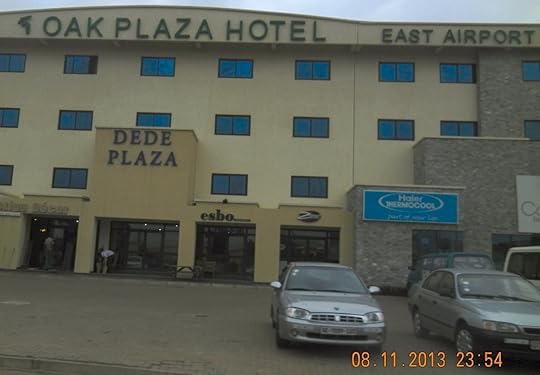
OAK PLAZA HOTEL ON SPINTEX ROAD
Or here, expensive and uninteresting:

THE LOBBY AT THE MOVENPICK HOTEL IN ACCRA
But wherever I travel–Ghana or otherwise–I try to find accommodations with character, theme or personality, like the unique Esther’s Hotel at which I am staying now. It has warmth and individual charm that most hotels could not possibly achieve in an urban environment such as Accra, among them the peacocks that wander the grounds and episodically take off and perch on the roof.
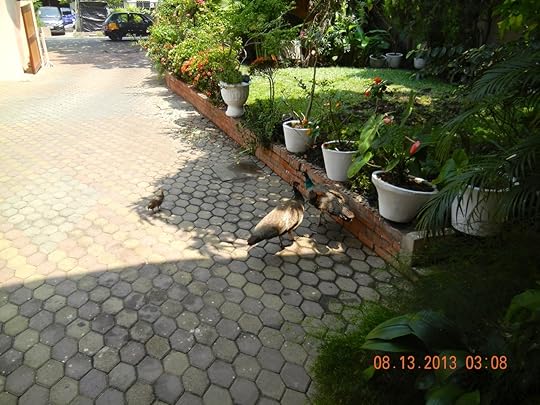
PEACOCK, PEAHEN AND CHICK (NOT THAT KIND) IN THE DRIVEWAY
In the morning, I get a visit from this chap outside my window:
Although they are not soundless birds, they don’t make a racket in the morning like a rooster or infernal guinea fowls would.
I find wood floors and ceilings irresistible. To me, wood is warm and welcome by its nature, whereas gleaming, artificial surfaces are not very compelling.
Who could resist something like this:
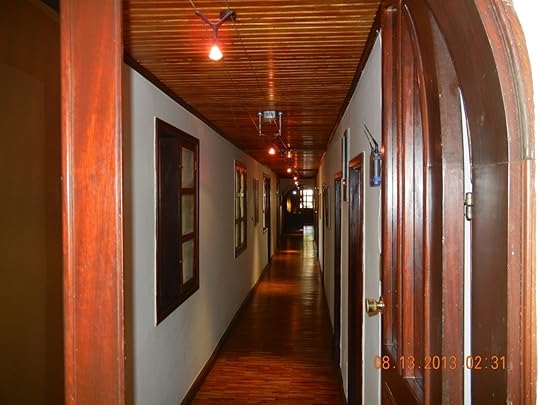
HALLWAY AT ESTHER’S
Or this:

ONE OF THE ROOMS AT ESTHER’S
Or this:

LOBBY AT ESTHER’S WITH FREE WIFI (YAY)
Incidentally it strikes me this is a great setting for an Agatha Christie type of murder mystery: a victim found in bed with a silver dagger in his back, a certain finite number of suspects–each of whom had a reason to hate the murdered victim, doors with the old-fashioned kind of keys and locks (none of that keycard stuff), wood floors and stairs that creak slightly with each footfall, (someone in one of the rooms would have heard the creaking late at night), an open window with the mosquito netting cut but no footprints in the garden outside . . . At the denouement of the story, our Hercules Poirot or Miss Marple-like hero would gather all the suspects in the lobby shown above, and in the classically tortuous manner of Dame Agatha Mary Clarissa Christie, he would show who is the culprit and why.
Esther’s Hotel is seventeen years old and owned by a Ghanaian woman whose name really is Esther. I talked to her this morning just before she went off for a game of golf, and she explained her love of nature, birds of all kinds, and lush vegetation–hence the peacocks in the setting of gardens that are well-tended but exuberant in character.

THIS TIME OF YEAR, GHANA’S WEATHER IS COOL AND PERFECT FOR SITTING IN THE GARDEN
Esther lived with her physician uncle in Germany for many years from the age of ten, and of note, the bathroom fixtures are all recognizably European in style from Siemens. Her passion for the hospitality industry was born when she was very young, and she clearly enjoys what she does. The staff take her cue of personalized attention and care, and the fact that her senior employee has been at the hotel from the very beginning says a lot. The food is excellent.
In two days, I’m headed for Kumasi, Ghana’s second largest city, where I hope to stay at a unique location again, as well as investigate the debacle of illegal gold mining, the setting for the fourth Darko Dawson novel, Nothing That Glitters.





